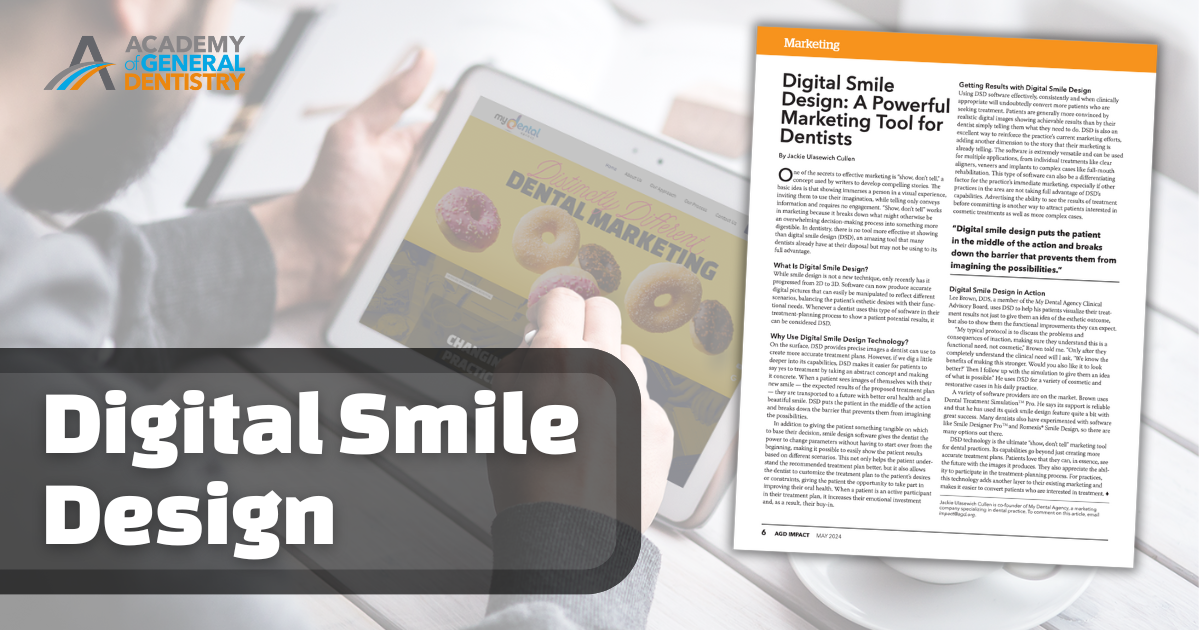This article originally appeared in the May/2024 issue of the Academy of General Dentistry’s AGD Impact magazine.
Digital Smile Design: A Powerful Marketing Tool for Dentists
By: Jackie Ulasewich Cullen
One of the secrets to effective marketing is “show, don’t tell,” a concept used by writers to develop compelling stories. The basic idea is that showing is more effective than telling because showing immerses a person in a visual experience, inviting them to use their imagination, while telling only conveys information and requires no engagement. “Show, don’t tell” works in marketing because it breaks down what might otherwise be an overwhelming decision-making process into something more digestible. In dentistry, there is no tool more effective at showing versus telling than digital smile design (DSD), an amazing tool that many dentists already have at their disposal but may not be using to their full advantage.
What is Digital Smile Design?
While smile design is not a new technique, it is only recently that it has progressed from 2D to 3D. Software programs can now produce accurate digital pictures that can easily be manipulated to reflect different scenarios, balancing the patient’s desires with their functional needs. Any time a dentist uses this type of software program in their treatment planning process to show a patient potential results, it can be considered a digital smile design.
Why Use Digital Smile Design Technology
On the surface, digital smile design provides precise images a dentist can use to create more accurate treatment plans. However, if we dig a little deeper into its capabilities, DSD makes it easier for patients to say yes to treatment by taking an abstract concept and making it concrete. When a patient sees images of themselves with their “new” smile — the expected results of the proposed treatment plan — in their mind, they are transported to a future with better oral health and a beautiful smile. Digital smile design puts the patient in the middle of the action and breaks down the barrier that prevents them from imagining the possibilities.
In addition to giving the patient something tangible to base their decision on, smile design software gives the dentist the power to change parameters without having to start over from the beginning, making it possible to easily show the patient results based on different scenarios. This not only helps the patient understand the recommended treatment plan better, but it also allows the dentist to customize the treatment plan to the patient’s desires or constraints, giving the patient the opportunity to take part in improving their oral health. When a patient is an active participant in their treatment plan, it increases their emotional investment and, as a result, their buy-in.
Getting Results with Digital Smile Design
Using digital smile design software effectively, consistently, and when clinically appropriate will undoubtedly convert more patients who are seeking treatment. Patients are generally more convinced by realistic digital images showing achievable results than by their dentist simply telling them what they need to do. Digital smile design is also an excellent way to reinforce the practice’s current marketing efforts, adding another dimension to the story that their marketing is already telling. The software is extremely versatile and can be used for multiple applications, from individual treatments like clear aligners, veneers, and implants, to complex cases, such as full mouth rehabilitation. This type of software can also be a differentiating factor for the practice’s immediate marketing, especially if other practices in the area are not taking full advantage of DSD’s capabilities. Advertising the ability to see the results of treatment before committing is another way to attract patients interested in cosmetic treatments as well as more complex cases.
Digital Smile Design in Action
Dr. Lee Brown, a member of the My Dental Agency Clinical Advisory Board, uses DSD software to help his patients visualize their treatment results, not just to give them an idea of the esthetic outcome, but also to show them the functional improvements they will see. “My typical protocol is to discuss the problems and consequences of inaction, making sure they understand this is a functional need, not cosmetic. Only after they completely understand the clinical need will I ask, ‘We know the benefits of making this stronger. Would you also like it to look better?’ Then I follow up with the simulation to give them an idea of what is possible,” Dr. Brown explained. He uses DSD software for a variety of cosmetic and restorative cases in his daily practice.
For dental practices wishing to start using DSD, there are a variety of software providers on the market. The brand name of the software Dr. Brown uses is Dental Treatment SimulationTM Pro. He says that their support is reliable and that he has used their quick smile design feature quite a bit with great success.
Digital smile design technology is the ultimate “show, don’t tell” marketing tool for dental practices. Its capabilities go beyond just creating more accurate treatment plans. Patients love that they can, in essence, see the future with the images it produces. They also appreciate the ability to participate in the treatment planning process. For practices, this technology adds another layer to their existing marketing and makes it easier to convert patients who are interested in treatment.












